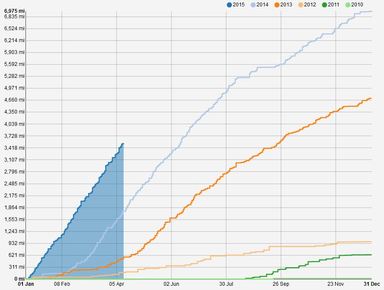 From VeloViewer, a Strava add-on. From VeloViewer, a Strava add-on. Much has been happening over the last four months at Andre Breton Racing. Below I want to catch-up anyone that might be following my activities. In particular, I want to introduce my new coach, Fort Collins resident Pat Nash; recollect the highlights from four weeks of training on the Big Island of Hawaii including an all day ascent and descent of Mauna Kea Volcano; rave about my new Jet 9 RDO from Niner Bikes; and lastly, provide a summary of my training to date in 2015. Since January 3rd, I've ridden over 3,600 miles on road, gravel, and single-track, climbed 167,000 feet, and recorded 219 cycling hours from 92 training rides. Judging from the slope of the lines shown in the figure to the right, 2015 is the left-most trend, my base should be stronger than ever going into the next season. Two Great Coaches: 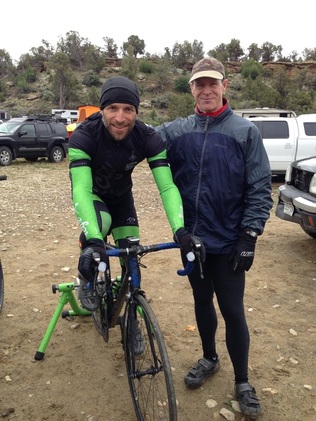 Warming up for 12 hrs Mesa Verde, 9 May 2015. Warming up for 12 hrs Mesa Verde, 9 May 2015. I've been asked by a few of my closest friends in cycling why I made the decision, last December, to switch coaches, especially after very successful seasons as an amateur mountain bike endurance racer in 2013 and 2014. During this time, I was racing and training under the coaching expertise of Alex Hagman, an accomplished pro-racer in both the road and mountain bike circuits.. At 44 years old, I'm not expecting to have a long racing career! This will be my second full-time season of racing, whether or not I can train and race to the extent that I am now in 2016 is already questionable because of other commitments. With the future uncertain, my decision to switch from Alex to Pat Nash was simply to give myself the chance to learn from two great coaches and mentors over my short racing career.. Every coach brings a long list of strengths to the table and eventually a student picks-up most of what they can. Of course, learning from Alex would have continued for several more years., but 'several more years' may not be possible for me at least at the pace of training and racing that I've adopted since April 2013. With all of this in mind, I asked Pat Nash to be my coach in December. Moving forward, I will always be grateful for all that Alex taught me, as well as his generosity when it came to loaning me bikes, introducing me to the Fort Collins cycling community, and much more. Without his guidance, my last two seasons would no doubt have been a lot different! Pat Nash is a member of Northern Colorado Grassroots Racing, the same team that I belong to in Fort Collins. He's been racing and coaching for over 40 years, both road and mountain. Some highlights of his coaching career include many success stories at the junior national level. Pat formed his own teams in Fort Collins and had many students over the years before he unofficially retired from elite-level coaching about 10 years ago. Several of these athletes received national and international acclaim while under Pat's tutelage, including state, national, and international championships. A few of the riders even went on to become professionals in road racing. Pat's recognition in the coaching community in Colorado went far enough to land him a one-time offer, with the possibility for extension, to coach the US women's national team (amateur status for Olympic eligibility) in South America. He was also often asked to coach at the Olympic Training Center in Colorado Springs along side of US National Team coaches at several mini-camps. Pat has started to get interested in coaching again, and for that, I'm a lucky fellow. He's not only an expert in endurance training, he's also meticulous in his coaching and passionate about cycling, At 44 yrs old, I feel exceptionally fortunate to have crossed-paths with an elite coach that was willing to take me on. And after 3.5 months of training, I'm already very excited about what I might be able to accomplish during the upcoming 2015 racing season. January 2015: Training on the Big Island 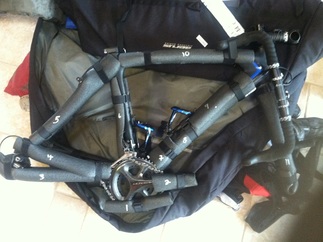 I want to thank Dr. John Kummrow from Integrative Physiotherapy for introducing me to Pat late last year. A few weeks and a few conversations later, Pat was already coaching me on the subtleties of staying fit in winter while balancing time to recover from a tough 2014 racing schedule.. I began training this year on 3 January, three days later I was en route to Hawaii for four weeks of training and exploring the big island with my fabulous, amazing, beautiful, and very patient girlfriend, Clarissa :). My former coach, Alex Hagman bailed me out (as he has many times) by loaning me his Aerus Biospeed bike bag when my purchase with a vendor fell through at the last minute. On the right is an image of my Giant TCR Composite 1 just before I started reassembling the bike in Hawaii. Clarissa and I landed in Hilo (aka, "Hilo-town") on January 4th, picked up our rental car, headed to the grocery store and then into the darkness towards the village of Pahoa where we had rented a modest house for a great price. Exhausted, but ready for the next day, we made it to bed about mid-night that first evening. Our base camp on the big island quickly acquired the nickname the 'jungle hut' because of the rain forest that surrounded us on four sides. Yet, inside and out, this modest home in the jungle offered all the modern conveniences plus the sounds of the forest for no extra cost. Among the native ohia lehua trees, native honeycreepers, especially amakihi, were often buzzing among the highest branches and singing as they flew between them. In the evenings, European mongoose, well established on the big island, left tracks on our windshield and joined the chorus of another well established non-native invader on the island, the 'ko-kee' frog (Eleutherodactylus coqui), named for its two note song. Based on cost, comfort, privacy, and jungle highlights, we would definitely recommend our jungle hut if anyone is interested in spending an extended time in Hawaii (send me an email). Pahoa, Hawaii, is located in the district of Puna (where I believe most of the hippies went after the 1960s), just east of Volcanoes National Park. Being fairly remote as far as 'the popular sites' on the island, Puna enjoys far less traffic on it's (very few) main roads relative to other big island destinations such as Hilo-town, and certainly, Kona, but also most of the coastline from Hilo to Captain Cook, a wide swath of the island. This being the case, I was lucky that, thanks to a good friend that lives on the island, Clarissa and I established a base camp in Pahoa. Over the next four weeks, I completed the majority of my training rides always within ca. 30 miles of the jungle hut.. One of the cycling highlights of the Puna District is a road that is still often referred to by the locals as the "red road". This name originates from the red cinders that, for many years, formed the roads surface. The red road runs along a large part of the Puna coast, from very close to the boundary with Volcanoes National Park to the southwest to road-ends close to "HPP" (Hawaiian Paradise Park) to the northeast, a massive housing development between Pahoa and Hilo and often the place where I would turn-back towards the south and Pahoa on long rides. Gradually, about 2/3rds of the red road has been paved. However, many miles of the northern third remain unpaved. Those sections are relatively remote and often rough, it was along one of these stretches that I surprised a wild boar (more below). If riding all the way to Hawaiian Paradise Park, then I strongly suggest planning all you'll need for a self rescue, such as carrying two tubes rather than just one. And be sure to bring plenty of water, I finished all of my rides on the island soaking wet from sweat, a very healthy four week cleansing! With overhanging trees, including plenty of coconuts up high and on the ground, and always within a few meters of the coastline, picture lava rock and crashing waves, the red road is a real treat for a cyclist. You'll find very few lines painted on the surface, few cars, and all told a very easy going pace set by the locals and visitors. Elsewhere in Puna, easy going remains the rule, and here I found many other road biking options. Choosing from among these and expanding them as the days and weeks passed, I easily put together rides, like this one, that were 3-5 hrs without doubling any section (here's another example). There were a few noteworthy incidences with dogs and a wild boar but fortunately none of my blood was shed during any of these encounters. On one of those adventurous days, I startled a boar that was foraging in the tall grass adjacent to the road. The animal charged to within inches of my rear wheel before deciding that he was going to let me live, swerve, and return to the forest. That left me breathless, and eventually laughing-out-loud for several minutes ... In addition to criss-crossing the district of Puna on my bicycle, I was able to sample other parts of the island on a few multi-day, multi-night, explorations far away from the jungle hut. For these trips, I traveled with the bike in the car, partially broken-down and wrapped in a large plastic bag from United Airlines. Plenty of planning was necessary to be sure that each day I met my nutritional needs, on and off the bike, and identified a route that was consistent with my scheduled training for that day. In addition, I had to maintain the bike and be sure I had what I needed to ride, spare tubes, bike kits, etc. Among the places that I discovered on these adventures outside of Puna, my favorites include a coastal route in Captain Cook, the Mountain Road between Waimea and Hawi (pronounced Ha-vi), descending into and ascending out of the Waipio Valley; and ascending and descending Mauna Kea Volcano from Hilo-town. Let me back up to December 2014, as my trip to Hawaii was approaching, I started searching for rides on the big island that people had written about on the internet. Very quickly, I came across two involving significant climbing, or 'just' a climb in one case, and decided life was too short not to attempt both of these. The 'just a climb' was a short, epic, ascent out of the Waipio Valley; the other was a series of consecutive ascents from sea level to the summit of Mauna Kea Volcano, over 13,000 feet of climbing in a single effort. Soon after I discovered the Mauna Kea climb, I started to visualize this ride as a Sea to Summit to Sea challenge and the more I thought about it the more excited I became. It would be an epic challenge for sure, if I even made it to the summit, but what a memory the day would be if I was successful! In the last few days of December, I decided I would make the Mauna Kea 'Sea to Summit to Sea' attempt on my 44th birthday, January 30th. Fast forward back to Hawaii, to January 24, Clarissa and I had slept well the night before in the best B & B we sampled on the island, the Waipio Hostel run by owner/operator Steve McPeek and his excellent team of friends and family.. The hostel is about a mile from the Waipio Valley Overlook where a famous descent, a steep, rough road of chinked together asphalt and concrete, drops into the valley - it's the only way in our out of the valley other than hiking trails. I had plans as big as the big island on this day starting with an out-and-back ride to Hawi via Waimea, a town up-slope of the coast where we were staying, a modest 5-6 miles as the ʻalalā once flew However, the only way to follow the (roughly) straight-line path of the Hawaiian crow to the town of Waimea was by a jeep trail named mud lane. Since arriving on the island, I had been spending a lot of time using Google maps to put together cycling routes, to varying degrees of success, and that's how I first detected a road through the jungle from just east of the Waipio Valley Overlook to Waimea. However, for this road, you really had to zoom-in, a lot (!), to provoke Google to suggest that it was a road ... rather than a digital illusion. That was my first clue, and also the first clue that I quickly disregarded. Shortly after I met Steve, I asked if there was a 'road' from the hostel that went south to Waimea., "that's right" he replied, "the road starts across the street" at which point he waved with his hand and spoke to take a right out of the driveway and then the first left. He also mentioned that a few years ago he was 'still' able to drive the road in a front-wheel-drive passenger car. But apparently, the road had since washed-out in many places, forcing him to take the long, roughly 15 mile paved (sane) route that went east for several miles before it turned west onto the highway to Waimea. In hindsight, Steve never discouraged me from taking the alternative, no doubt, scenic route, but there was a subtle hesitation as he contemplated my road bike and it's skinny little tires, the only bike I brought with me to the island. I ignored that hesitation too. Ascent of Mud Lane: Waimea to Hawi Out & Back 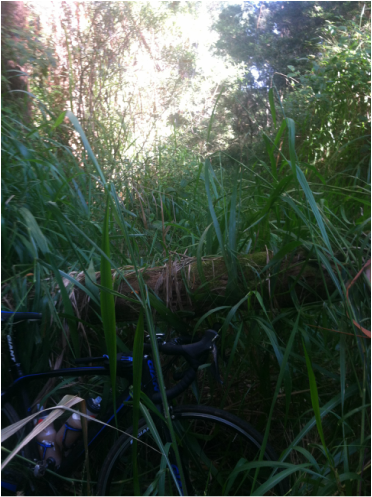 The pig trail I lost my way on as I was ascending Mud Lane. The pig trail I lost my way on as I was ascending Mud Lane. At about 8 am, I took a right out of the driveway and then the first left, a street sign confirmed Steve's directions, 'Mud Lane'. At this point, the road was paved, but I'm guessing the grade directly ahead approached 20%.. That was a hell-ya-good-mornin moment! I went from cool to warmed-up all within about 2 minutes after leaving the hostel. At the top of the first ascent, I crossed the main road that dead-ends not far away at the overlook, on the opposite side Mud Lane turned to dirt. Another steep climb, past a few local residences, and then a water tank, before the vegetation leaned over the road, from lack of use, and the water damage began to become apparent. A few more minutes of pedaling brought me to a well-used Toyota pick-up with two dogs in the back and a sleeper in the drivers seat. Barking dogs quickly awoke the sleeper, no doubt startled by the appearance of a kitted-up road cyclist on Mud Lane, he nonetheless kindly waved me past his barking dogs and wished me well. I passed-over an old concrete bridge, below a small creek was patiently accepting its gravity assist to the sea, on the other side the road transformed to exposed bedrock mixed with deep gulleys and loose gravel. Also, the grade was steep, easily 10-15%. Inevitably, I was unable to clean this section on the Giant even with 4000s Continental Tires, exceptionally sticky and tough. But honestly, any sane roadie at this point would have been miles down the (longer) paved route with Mud Lane nearly forgotten. But that isn't the way a mountain biker operates, the rougher the road became the deeper I stubbornly dug in, and soon I was hiking my bike up a road that was more downed tree and overgrown veg than road. At about this moment, I decided that I had, for the second time in a month, completely lost my way in the jungle (see image at the top of this section). Not lost, but definitely on the wrong path, that is unless I was looking for herds of wild pigs which I was not! I later recalled that Steve had in fact mentioned the left turn at the top of the hill that I failed to take on the first pass. But I think, in my defense, my senses were by this time focused on the terrain and the bike (survival) more than directions. After leaving the dogs and the stranger, it was a full-on, moment-to-moment, challenge to stay on the bike or even walk when I wasn't able to clear an obstacle. Here's the 'mud lane climb' segment on Strava, just the first section of a much bigger ride to Hawi and back to the Waipio Overlook. Note the 'mud lane climb' segment (on Strava) does not include the few miles of paved, blissful (!!), road at the top. It took me 32 minutes to ascend the jeep trail section of Mud Lane, including several minutes lost on the pig trail. I averaged just 6.2 mph and climbed 1,064 feet over 2.9 miles, this is some of the evidence of the challenge of making this climb on a road bike. From the top of Mud Lane, smiling and relieved all at the same time, I made a right and soon was pedaling through busy downtown Waimea. From there, following two rights on the other side of town, I was quickly climbing again but this time on a well marked, paved, road on my way to Hawi on what the local's refer to as 'the mountain road'. After the adventure on Mud Lane, I could have used a longer break before tackling a climb of this significance. And on top of that, the climb from Hawi back to Waimea was even more difficult. Nonetheless, with few cars and beautiful scenery, I felt exceptionally fortunate to be in that place, and on my road bike, among the singing birds, green fields and sunshine. Cars and trucks zipped past from time-to-time but otherwise I was alone among the pastures and hills, cleansing my lungs as I made the climbs with the air off the Pacific and spilling down the slopes of the nearby volcanoes and cinder cones. I was in the zone that cyclist imagine when they picture places like the mountain road ... life was long instead of short, not a moment was wasted ... and soon I was back at the top of Mud Lane. Someone less stubborn than me would have taken the paved road back to the Waipio Valley Overlook, where I intended to finish the day by descending and then ascending the valley road. Myself not included, I turned left onto mud lane from Waimea and soon was descending in my drops, with plenty of brakes, over that bedrock I mentioned earlier, mixed with deep ruts and loose stone, and often on steep descending grades.. My arms and shoulders burned from the constant effort to maintain control of the bike on the technical terrain. And unfortunately, part way down, the rain-forest quality of this region of the big island showed itself in the form of a heavy down pour. Within moments I was soaked through, toenails to eyelashes. That made a difficult descent even more of a challenge, but without any other option than up, I rolled, pedaled, pushed, and scrambled my way back to the bottom of mud lane and then rode a short distance, about a mile, to the overlook without experiencing any break in the rain. Moving time from the B & B, where I started my ride at about 8 am, to the overlook was 5 hrs 21 minutes; distance and elevation gain, 67.8 mi and 8,356 feet. A sufficient warm-up no doubt to attempt the first of two climbs that I had been reading about and anticipating for weeks. Waipio Valley Climb: Here's a quote from Wikipedia describing the road into the valley that descends from the Waipio Valley Overlook: "... the valley floor at sea level is almost 2,000 ft (610 m) below the surrounding terrain. A steep road leads down into the valley from a lookout point located on the top of the southern wall of the valley. The road gains 800 vertical feet (243.84 m) in 0.6 miles (0.9 km) at a 25% average grade, with steeper grades in sections. This is a paved public road but it is open only to 4 wheel drive vehicles [and crazy people on bicycles :)]. It is the steepest road of its length in the United States and possibly the world." 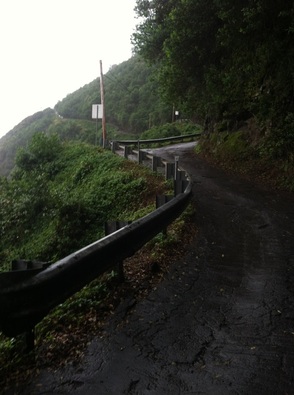 Despite the own into then out-of the valleyshortness in mileage and time required for this challenge, it's a ride that shouldn't be underestimated (here's some details about Lance Armstrong's climb out of the valley). A legitimate warm-up, for example, is a must before attempting the climb. As I described above, I warmed-up for over five hours, that may have been a little too much! On the steepest sections, tackling grades in excess of 25%, I averaged only 3.1 mph over a half mile.. As I climbed, my legs were more desperate to stop than they had ever been before, this was a pain cave that I had not previously visited. my legs were more desperate to stop than they'd ever been before, this was a pain cave that I had not previously visited. my legs were more desperate to stop than they'd ever been before, this was a pain cave that I had not previously visited. At the peak of my suffering, digging deeper than I knew I could, I was just barely able to turn the crank enough to keep the bike from falling over. Like a scene out of the 1982 film Blade Runner, as I climbed the rain poured down, spilled off my body in dozens of tiny waterfalls, and flowed down the road, past my bike and a few hikers, in fast moving torrents which I tried to avoid but wasn't always successful. rain pour-down, rain ran off my bike and body is drips and streams, and down the road in a fast moving, but shallow, torrent. On the steepest sections,Reaching the summit, just 2.8 miles and 30:42 min:sec after I started, was an achievement that a cyclist might have to experience to really understand. Despite it's short length, the ascent out of the Waipio Valley leaves a lasting impression. For myself, that impression was shared with not another soul! When I arrived back to where I had started, on the rim at the Waipio Valley Overlook, I was greeted by only wind and more rain. Nonetheless, I smiled big enough for a world to notice, and then gently covered the distance back to the Waipio Hostel. About an hour later, after a shower and a meal, I walked back down into the valley and rejoined Clarissa where we spent the night and hiked out the next morning ... it was still raining! For the cyclists, my 2014 Giant TCR Composite 1, the bike I rode all day including the ascent of the Waipio Valley, was pretty-much stock, from the factory. Exceptions were tires, I used Continental Grand Prix 4000s II front and rear, 25 mm. My drive-train, Shimano Ultegra 50-34 chain ring and 11-28 cassette came with the bike. I use pedals and shoes designed for mountain biking, SPD pedals and Shimano SH-XC70 shoes. Ascending and Descending Mauna Kea: Sea to Summit to Sea 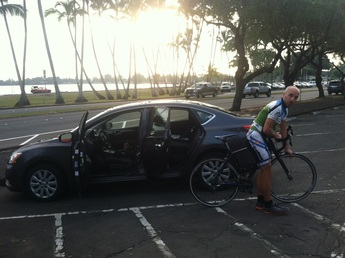 Moments before starting the ascent from Hilo to Mauna Kea. Moments before starting the ascent from Hilo to Mauna Kea. Totally knackered, but celebrating, I walked with Clarissa the next morning the few miles from the hostel in the valley back up to the Waipio Valley Overlook. Seeing the climb from my running shoes, and snapping a few photos, was a nice way to conclude that challenge. Along the way, Clarissa and I had to hold on to each other as we crossed the swollen river that runs through the middle of the valley. Over the next few hours, we drove through Waimea and then into Hawi by-way-of the mountain road. Based on the satellite weather map, this route seemed to take us through the only available sunshine. And this was fortuitous, because I really wanted Clarissa to see the views from the mountain road that I had seen the day before. The views certainly compete for the prettiest road-side scenery that I encountered on the Big Island. About two days later, as we had a few times before during the month, Clarissa and I returned in the dark to the jungle hut and slept a long deep sleep until morning. No doubt, that first morning back, we sipped Colorado roasted Camp 4 coffee a little longer than usual as one of us swung in the hammock on the back deck and the other sat on a step nearby. By 10 am, late, I was rolling. Then back to the jungle hut a few hours later for lunch and then probably a beach or snorkeling trip with Clarissa in the afternoon. By this time, days were creeping-up on January 30th, the day I was hoping to attempt my ascent of the volcano. Now just a few days out, the weather looked excellent. The attempt would start from Hilo, a few meters above sea level. Clarissa and I decided on a 6:15 am departure from the jungle hut, I assumed it would take only 45 minutes, or less, to drive into Hilo. Unfortunately it took much longer, delayed by the traffic I finally climbed onto the bike at about 8:15 am. But in hindsight, as long as I wasn't planning on stopping more than briefly, an 8 am departure was not so bad. It ensured that, barring any unexpected weather, the temperature at the summit would be in the low to mid 40's by the time I arrived (I was expecting sunshine based on the weather predictions and that's what I got, fortunately). It also ensured that the temperature climbing out of Hilo-town wouldn't be overly hot, it was about 65-70 F when I rolled out of town and onto the first climb. Clarissa and I had planned for her to drive close to me, following from behind, until we were out of town. In part, because this meant she would have to navigate fewer directions on her own - she's German by the way, a resident of Hamburg, where she rides her bicycle everywhere and uses trains to cover the longer distances. Sensibly, she doesn't own a car! So our plan was to keep her close to me until we were on the Saddle Road, a straight shot up to the right turn that would take us to the summit. That was the plan anyway, until we found ourselves on a road that, despite being two-way, becomes one-way in the morning (all four lanes) when parents are dropping their kids off at a local school. Within a few minutes of leaving the downtown water-front area, Clarissa and I were looking at each other, puzzled, as oncoming cars approached us on our side of the road. When it became impossible to continue, I shouted a few words through her open window from a distance and then I headed up the sidewalk! She turned around and that was all I saw of her for about an hour. I thought for sure that something had gone wrong, until she rolled up next to me part way up the Saddle Road, what a relief that was! From Hilo, I started with two 28 ounce Camel-bak water bottles mixed with two scoopes (each) of Hammer perpetuem. In my jersey pockets, about 6 GU gels and a CLIF bar. Strapped to the bike, mountain bike style, I had what I needed to fix a flat. With Clarissa rolling nearby and checking on me from time-to-time, I didn't need to overdo what I had in my pockets, a privilege. I kept the same set-up on the bike as I had for the Waipio Valley ascent (see details above), except that I changed my tires from Continental 4000s II 25 mm to Continental Contact 28 mm. The tire change was in anticipation of the ca. 5 mile gravel section (don't miss this excellent article including images from a professional photographer) above the visitor center on the ascent of Mauna Kea. In hindsight, the 28 millimeters wasn't near enough to really 'ride' that very difficult section for a road bike. Of course, it's possible that it spared me a flat, especially descending the gravel at high speed. But the 4000s are also very tough tires in my experience. If I was to do it again, I would probably put 95 lbs in the 4000s front and rear and let-er-rip. The Conti 4000s tires wouldn't slow me down on the gravel section and they would certainly speed me up on the road sections, the majority of the route which covers 42.5 miles from Hilo to the summit. So, about 85 miles Sea to Summit to Sea. The 'Saddle' Road is named for the area that it rolls over at its highest point: a saddle between the most prominent volcanoes on the island, Mauna Kea and Mauna Loa. It's the main highway between Kona and Hilo, or the Kona-side and the Hilo-side as locals often refer to them. About half-way between the "sides", Mauna Kea Access Road heads north and then quickly begins to ascend the volcano. About 6 miles up, you'll encounter a visitor center and the gravel that I mentioned in the last paragraph. At the end of the gravel, the road is again paved and remains so all the way to the summit at 13,796 feet (4,205 m). My plan on the saddle road was to climb at a strong pace but without putting too much of a drain on my tank. In particular, I was concerned about what I would need to climb the last few thousand feet, including the gravel. Nonetheless, I covered the saddle section (about 22 miles) at a reasonable pace, it took me a little over two hours from town. At the top of the saddle, I turned right onto the Mauna Kea Access Road and gave myself permission to have a quick pee! It wasn't a race after all!? By this time, I had burned through my first two bottles and a few gels. Clarissa handed-me-up replacements and I rode on. I was feeling good, a little over 5,000 feet of climbing was already in the bag, 'only' 8700 remaining :). The access road wastes no time in its pursuit of the summit, shortly after making the turn I was looking up at a monster of a climb. It was time to settle-in, to survive, and sometimes to allow myself to be distracted by bird song, sunshine, and scenery. It was a gorgeous day, with little wind and very few cars/trucks passing by. And those that did often had their window down as they approached and the occupants were shouting encouragement! It was great to know that I was among friends and no doubt it added a little bit of power to my lungs and legs on each encounter. The next major section, Saddle Road to the Visitor Center, took me about 57 minutes to cover 6.2 miles. Along the way, 2577 feet of climbing at an average grade of 8%. 'Just' 5700 feet, about a vertical mile, to go. I made my second stop at the Visitor Center where Clarissa was waiting for me. This was a scheduled stop, I laid the bike down and prepared my jersey pockets for what I might need to survive (not be comfortable) if the weather turned to shit on the mountain. The exchange took about 3-4 minutes, a quick kiss for Clarissa and I was on my way again but this time with a fellow I had met riding along the red road. His plan was to ride with me to the summit form the Visitor Center, a very generous offer and one that I was thrilled to accept. We rode the gravel together, though separated at times, I finished that section just behind him. As we rolled back onto the pavement we found a very prominent pile of stuff waiting for us, it had been stashed there by Clarissa. Ahead, we would later learn that she had also stashed food, etc, at the summit. This was exceptional given that our rental car was not up-to-the-task of climbing the steep gravel sections, Clarissa had gone above and beyond as a support crew and hitch-hiked her way to the summit with our supplies. Before I move-on to the pavement above the gravel, where the atmosphere, void of any oxygen, eventually abandons cyclists, let me reflect for a moment on my experience covering the five miles of gravel. Everyone writes that it will be tough, really tough, brutal, you will experience melt down, a few miles of hell, hellish, humbling, unimaginable cruelty, and much more. However, all of us as cyclists read it, respect it, but then transition to an image that is much more 'normal'. Sure, it'll be tough, I will suffer, but ... then you get there and you realize that you're coming apart, especially mentally. I pictured launching my bicycle over the guardrail at one point, sure happy I didn't actually do that. I swore, loud. I came off the bike (spun out) about 6 times and then lost track. I walked three or four times. Once, about a 1/3 of a kilometer. Before I made it half-way, I was bashed, beaten, humbled beyond mercy, I was losing this battle. And I hadn't been arrogant about the section, I just didn't know how tough ... tough could be on a road surface like this, with only a road bike, at high elevation. Few instincts remained intact at this point, but one was 'I could still determine which direction moved me higher onto the mountain' ... so that's where I pointed my body and bike. Forward. Up the mountain. Spinning in granny, spinning out, or walking. And eventually, near the top, my companion on his mountain bike rejoined me, I settled down, reconnected with the moment, and then rolled on to the most beautiful, gentle, loving asphalt I have ever witnessed or ever will witness again I suspect! My advice for climbing the gravel is .... if you're not stubborn, like me, consider using two bikes to make the climb. Use a mountain bike for the dirt, and possibly the pavement above it or use a support vehicle that can move your road bike up the mountain for you. Martin Roff flew from his home in Norway with a cross-bike, a relatively comfortable alternative, to the road bike, a cross-bike would accommodate lots of drive-train and tire options as well. As far as surviving the gravel, regardless of your steed, you must to reach the summit. So prepare as best you can and then ... maintain forward progress, be stubborn and you'll get there. It took me 1 hr and 14 minutes to cover the 4.6 miles of gravel, I gained another 2400 feet on this section at an average grade of 10%. When the gravel sufferfest ended, about 3000 feet of climbing remained, all of this above 10000 feet (3048 m) elevation. Clarissa and her hijacked support vehicle rolled-up to me on the gravel when I was in a bad place, mentally, they quickly drove away! Part way up the pavement, as they were descending, they dared to stop one more time, and this time I was ready, and apologetic honestly! They surprised me the first time around. I stopped for 2-3 minutes to speak with them, I waved them down as I felt like they might just drive past. At that moment, I was at 13,000 feet. A moment before I had been methodically turning my cranks, and breathing, just breathing, slowly. An unanticipated effect of the rarefied air was a feeling of peacefulness despite the suffering in my legs and lungs. I remember being at peace, honestly, it was amazing. I don't remember much of what we spoke about, but I remember that I felt better, a lot better, physically, as I pedaled away from Clarissa and her new friends from the UK. Perhaps it was the realization, processed over the few minutes that I had been able to look around as we spoke, that I was within about 1 mile of the summit. I could see it, just a massive climb remained, one more, the last push ... and I could get there! It's beautiful up on the mountain, so far above the Pacific Ocean where humanity is barely detectable far-down below. For hours now I had been pedaling above the clouds that had steadily gathered on the Hilo-side. Looking down on them, I reflected on books I had read about mountaineering, 'Into thin Air', 'The Climb', and others. At times I forgot about the bicycle that I was propelling, at those moments I was a mountaineer ascending an epic peak and enjoying a privileged top-view of the clouds as I pulled myself higher and higher into the void. I made it to the first turn that I had been looking way-up-at from the jeep, and at that point the road actually descended a few feet before making a hairpin left. Now I really was at the last climb and something strange happened, my mind and body really got excited ... how does flesh know that the end of a brutal test of mental and physical perseverance is about to end? The reason isn't so important, but the effect was thrilling ... my legs found a reserve that I don't know how to access and together we picked-up the pace and a moment later I was riding a circle at the highest point of the road, not actually the true summit but the summit for anyone that wants to ride a bicycle to the 'top' of Mauna Kea (you could hike the last few meters if you wanted to!). Alone on the summit, among more than a dozen world-class deep-space telescopes, the sort of telescopes that probe into our solar system, to Neptune and beyond, into interstellar space and neighboring star systems, and farther. Clouds below, an ocean of blue beyond, massive telescopes, I was alone in a magical place at the end of an ascent that I was grateful beyond words to have been able to attempt. And there I was, standing in a strong atmospheric disturbance, a wind, it was cold but nothing could distract me, for the first few minutes, from taking it all in. Living and experiencing ... thanks to the gift of cycling ... an emotional and physical moment that no material object can ever offer. To know this you must live it, you must cross threshold after threshold of perceived barrier, and propel yourself by any physical means (bike, foot, etc) to far-away, far-out-of-reach destinations such as the summit of Mauna Kea. When you get there, the suffering will be forgotten ... My ascent from the top of the gravel to the summit, a distance of 3.5 miles with 1952 feet of climbing, took one hour. I recall only spending about 5-10 minutes on the summit. It seemed much longer, but eventually I began to feel the cold from the wind and the sweat on my body. It was time to descend, and descend over 13,700 feet in a single drop! As I made the first turn from the summit I was reunited with my friend on his mountain bike. We exchanged plans and high-fives before I continued down the mountain. An instant later I was at the gravel. Initially, I was cautious, but then I let the giant rip ... a moment later, both tires inflated fortunately, I was hugging Clarissa at the Visitor Center. A good friend on the Island, Julia Rowe, and her two sons made the drive to the Visitor Center to join in the celebration! That was emotional, to see them all there. But after about 30 minutes, clouds now thick towards Hilo, I had to finish my descent. With stops, it had taken me 5 hrs 59 minutes and 41 seconds to make the ascent from Hilo to the summit. In less than 2 hours, not including the stop at the Visitor Center, I descended from the summit to Hilo. I think I smiled as much as I otherwise will in my lifetime on that epic descent back to sea level. And I smiled even though I flatted part way down when I smacked a rock ... visibility was a big problem as I descended through the clouds and into heavy rain. As we had at the beginning, Clarissa and I had some trouble reuniting at the end. But eventually, thanks to friends, we found each other. By then running late, I had only enough time to pack the bike, jump into the car, and quickly drive to Julia's for a post-Sea-to-Summit-to-Sea party! When I arrived I was surrounded by aloha ... and mahalo ... and fortunately, was given permission to use the shower! For more details of this climb, or any other ride that I went on in Hawaii, anyone is welcome to contact me. In the meantime, make plans .... and go on your own epic climb into the thin air above 10,000 feet ... and consider posting your story on your own blog. 2015 Training To-date & a Niner Jet 9 RDO 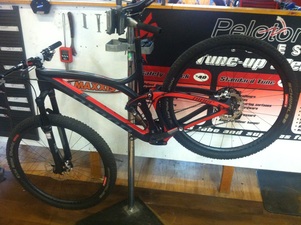 My new whip arrives to Peloton Cycles! My new whip arrives to Peloton Cycles! Since March, there has been a new whip in my living room, a 2015 Jet 9 RDO from Niner Bikes. In hindsight, all the reluctance I had to ride a full-suspension (aka, "squishy bike") in place of my tried/tested/proven hard-tail has vanished in the last few weeks as I've gotten to know just how capable, all around, this Jet really is. Of course, on descents of 10-20 minutes, the Jet literally shaved 1-2 minutes off my best time compared to the Air 9 RDO. However, that's not a surprise. What is surprising is the pace that I have been able to maintain when I'm on other terrain, namely rolling on flats and dips, and climbing. So far, after about 6-8 rides on the Jet, I'm not experiencing any declines in times on these terrains No doubt, the Air 9 is an epic bike. But if I absolutely need to choose just one then that one will likely be the Jet. In the meantime, I'm hoping to hold onto both bikes and use them both during the upcoming 2015 race season. On January 3rd I began training, a month earlier than 2014, with a new coach, new ambitions and goals. Since that day, I've ridden over 3,600 miles (5764 km) on road and mountain terrain, about 1000 miles a month. Of course, including the Mauna Kea ascent from 30 January, I've accumulated a respectable amount of climbing over those 3600 miles, to-date 167,000 feet (50,901 m). When today is over, training day 106, 93 rides and over 224 cycling hours will be in the bank. But more important than distance, climbing, etc, is the quality of the rides, the quality of the training, it's structure, planning, etc. With Pat Nash, I'm more structured than ever before, each week a totally new challenge, often more than one. My body, if it survives, and presently it's certainly run down (I'm becoming fatigued by design) from all of the work over the last 3.5 months, will be stronger than ever. That seems inevitable, but then again, the universe is a fickle beast. Stay tuned for more from Andre Breton Racing ... and thanks for dropping in. Images from top-left to bottom-right: A reflection of Clarissa and I at a snorkeling area not far from our Jungle Hut; a view from the Waipio Valley Overlook (beach at the end of the valley on the left); a picture taken from the saddle of my Giant TCR Composite 1 as I ascended the mountain road from Hawi to Waimea; (bottom-left) another image of my ascent on the mountain road (Waimea to Hawi); shortly after making the right turn off the Saddle Road and onto the Mauna Kea Access Road; the last four images (second row right, all bottom) were taken close to the summit/or on the summit of Mauna Kea by Clarissa. The image below is also from the summit area, another fantastic image captured by my one-person support team! Bottom two images: Clarissa, my solo support team, on the left! And, on the right, the sign that everyone encounters just above the Mauna Kea Visitor Center where the road turns to gravel/dirt.
|
�
André BretonAdventure Guide, Mentor, Lifestyle Coach, Consultant, Endurance Athlete Categories
All
Archives
March 2021
|
Quick Links |
© COPYRIGHT 2021. ALL RIGHTS RESERVED.
|


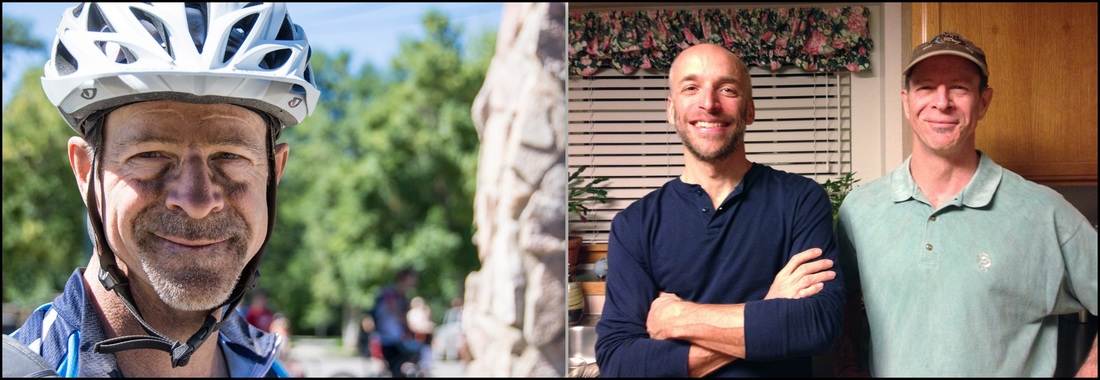
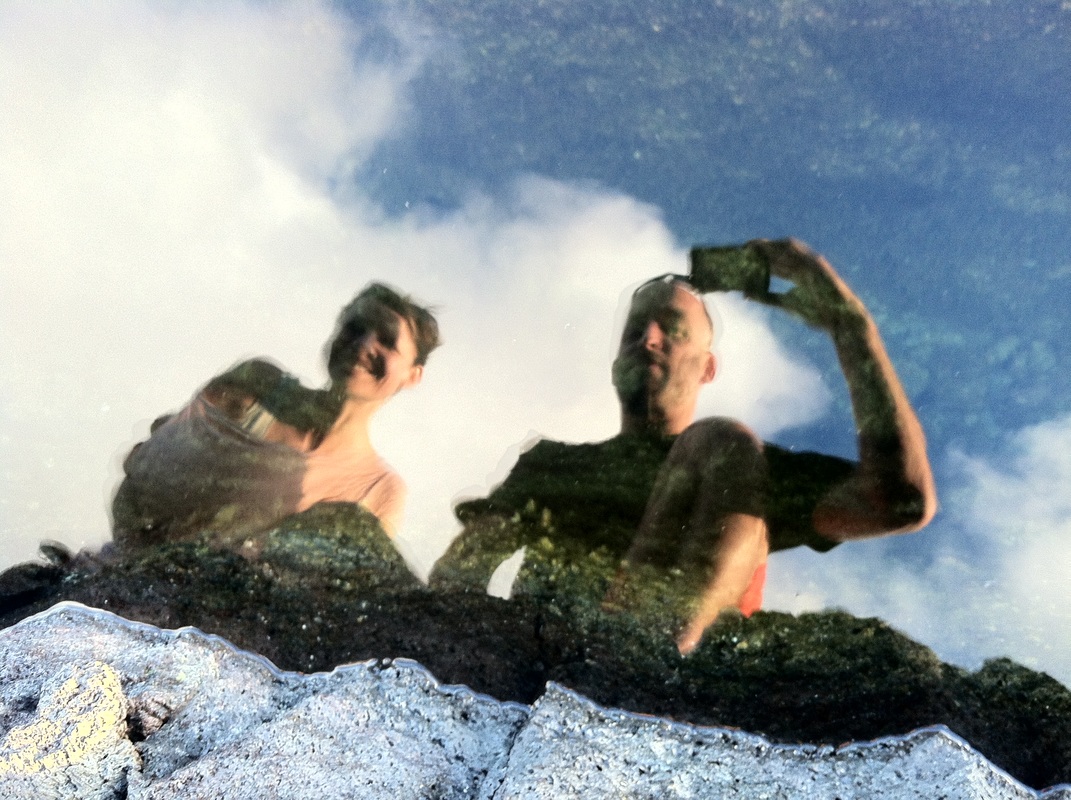
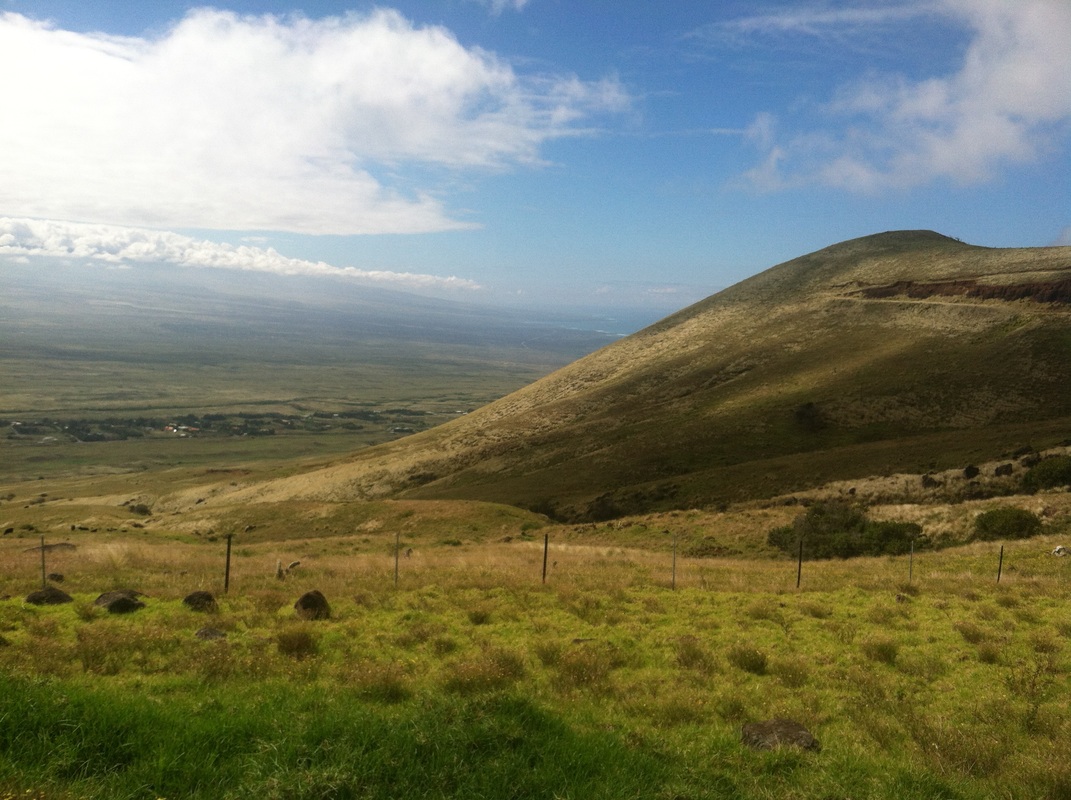
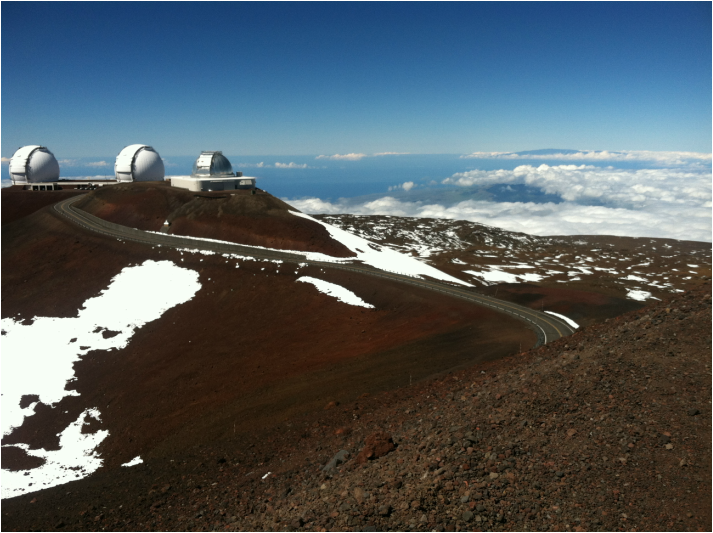
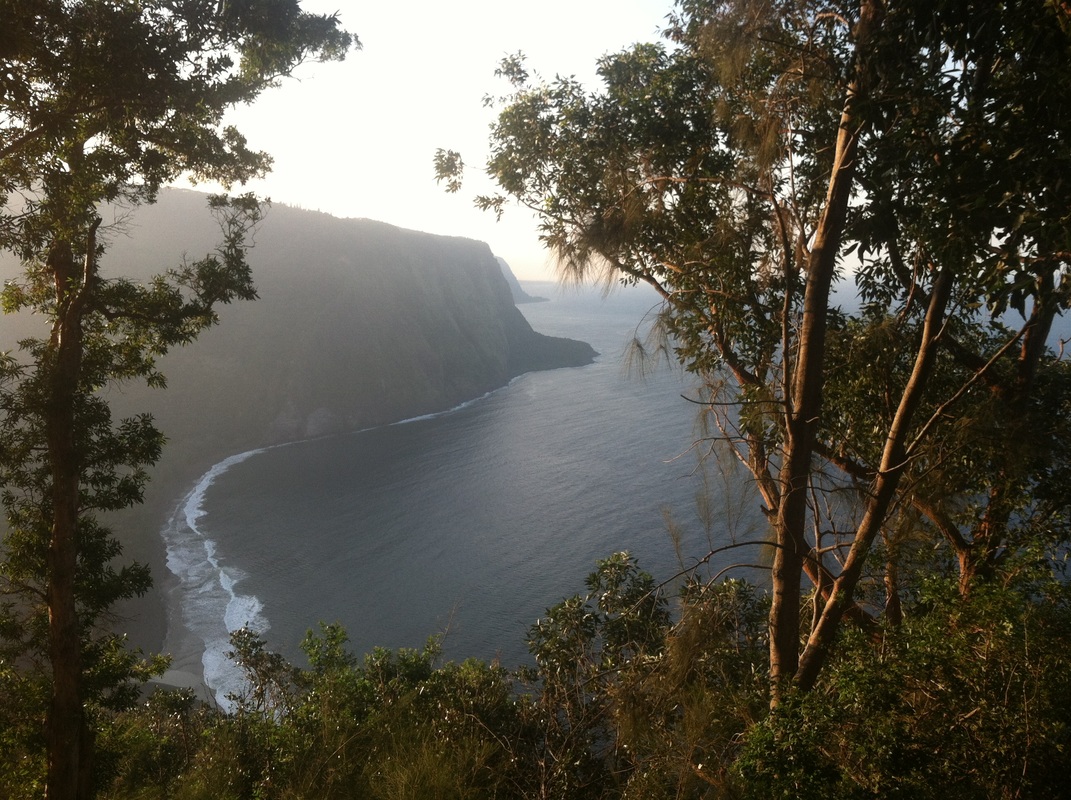
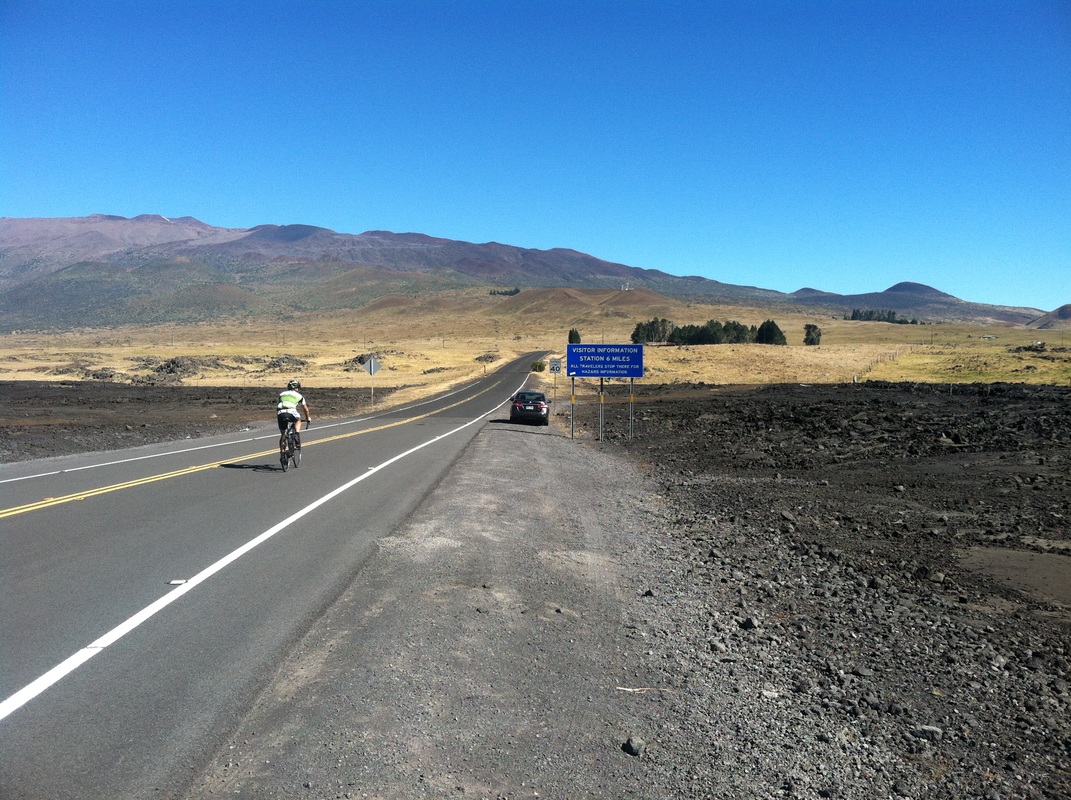
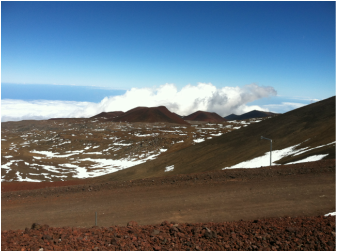
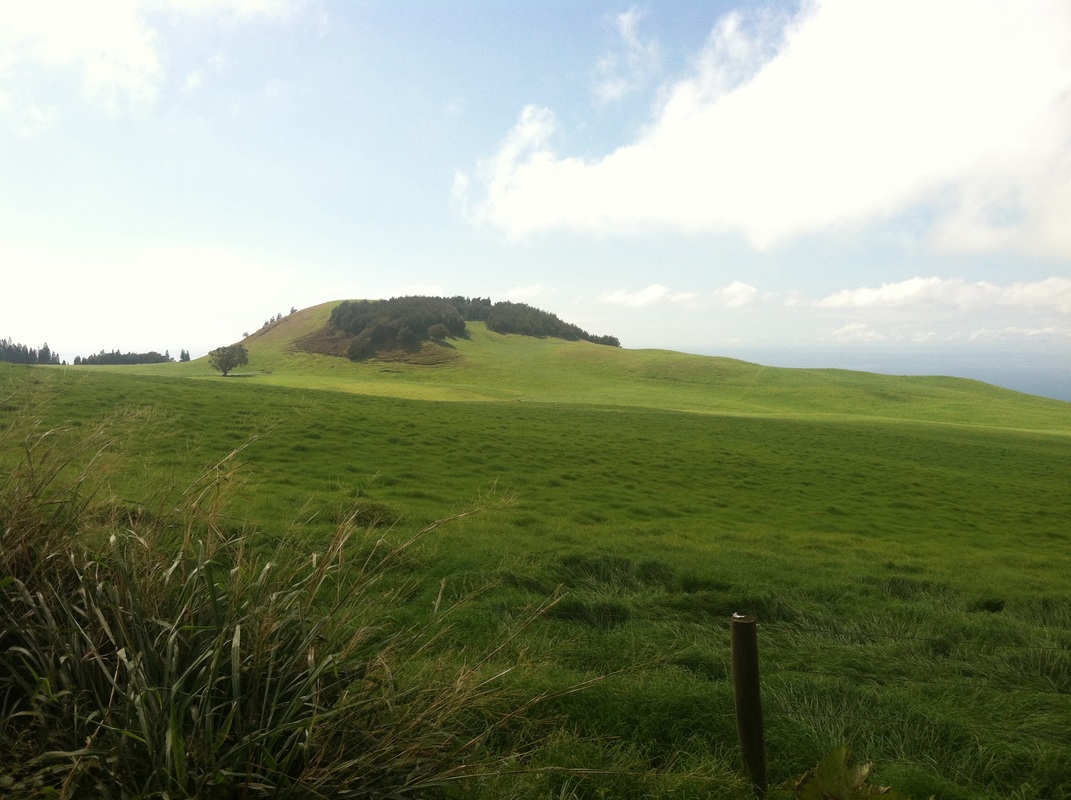
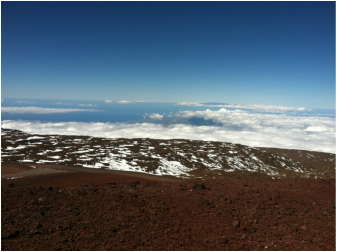
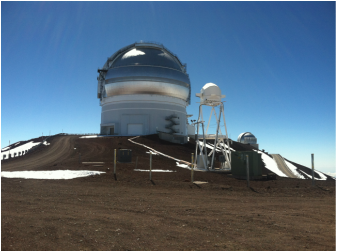
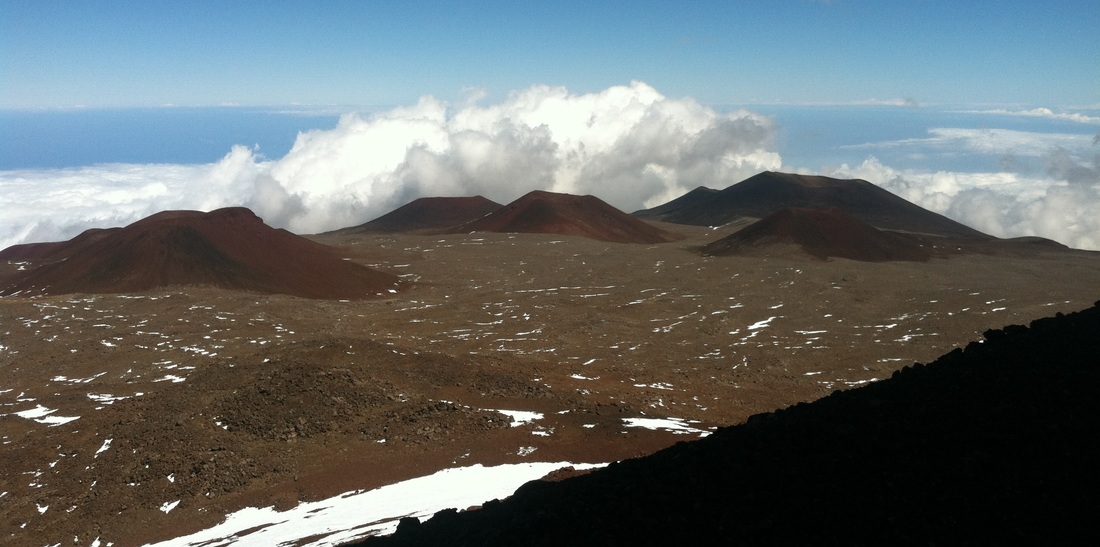
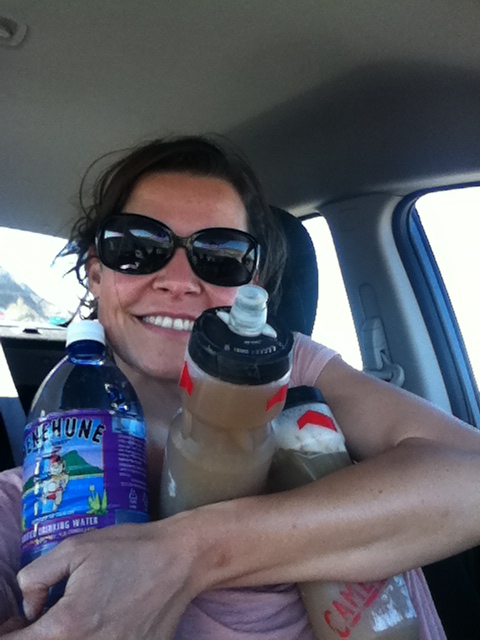
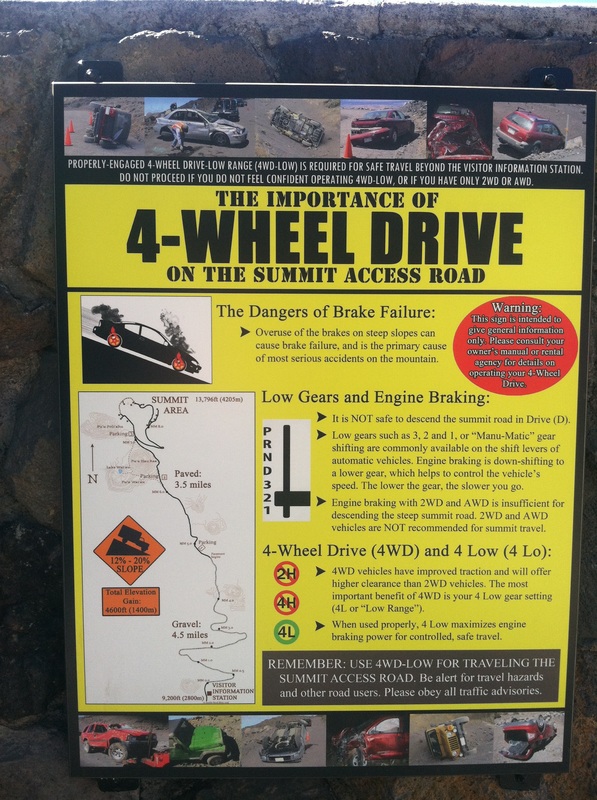
 RSS Feed
RSS Feed